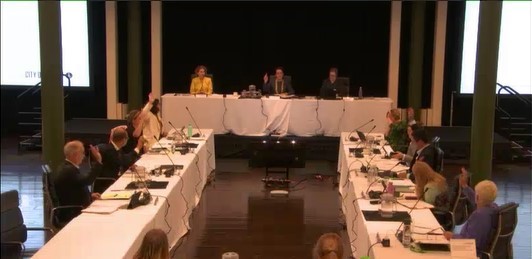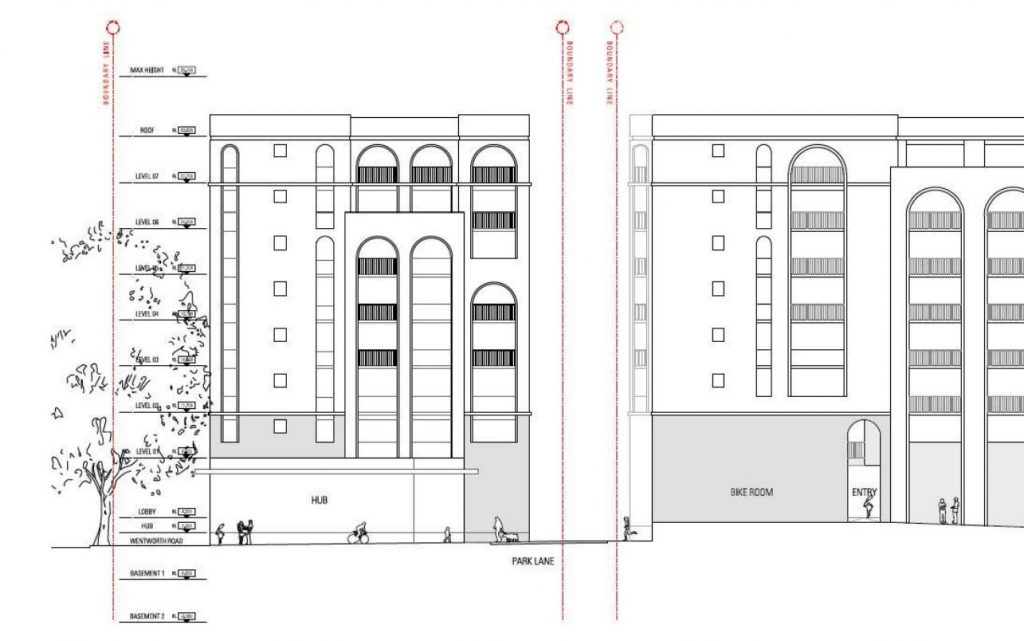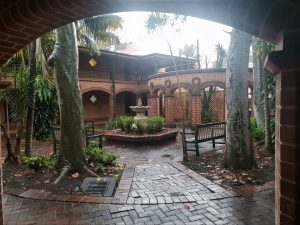by Ian Stephenson, Planning Convenor, April 2021, from Bulletin 2/2021
Nearly forty years of good planning designed to conserve the scale of the St Phillips Heritage Conservation Area through height controls was overturned on 29 March when Sydney City Council approved the NSW Land and Housing Corporation’s application for a spot rezoning of 17-31 Cowper St and 2A-D Wentworth Park Rd.

The rezoning removes two allotments from the St Phillips Heritage Conservation Area and amends the Local Environment Plan to enable the erection of two eight-storey apartment buildings.

Buildings in Glebe’s conservation areas are ranked Contributory, Neutral and Detracting. The difference between Neutral and Detracting buildings is primarily about scale. In the part of the St Phillip’s Heritage Conservation Area which is being rezoned, there is only one Detracting building, the 11 storey John Byrne Court. In the entire HCA there are only two, the other being the Glebe Telephone Exchange in St Johns Rd.
The sites which are being removed from the conservation area contain a pair of two-storey 1980s infill buildings comprising four terrace houses and 15 one-bedroom flats. The 2012 Development Control Plan directs that the ‘demolition of neutral buildings will only be considered where it can be demonstrated that the replacement building will not compromise the significance of the conservation area’. A pair of eight-storey buildings clearly will; however, the NSW Land and Housing Corporation’s solution to the conflict is to apply for a spot rezoning to remove the buildings from the conservation area.
On 22 March – the day Council’s Transport, Heritage and Planning Committee [THPC] were considering the proposal – the NSW Minister for Housing the Hon. Melinda Pavey announced that the development would be 100% social housing.
It was bitter-sweet advice. Sweet because it increases the amount of social housing and bitter because the planning is inept. Rather than being a ‘visionary housing development’ which ‘will blend seamlessly into an historic environment’ as the Minister claims, it will destroy the scale of historic Glebe.
The people of Glebe have warded off many threats in the past including slum clearance, freeways and home unit blocks.
Now is the time for renewed effort with State and Local Government to ensure the character and identity of our unique suburb is cherished and nurtured through sound planning controls for once it’s gone it’s gone forever.
The NSW Government is the largest landholder in Glebe. The amount of social housing could be increased through sensitively designed low-rise infill development, as was done in the 1980s. This approach both respects the urban fabric and is better to live in. Instead, the State Government is taking the lazy path by forcing through a rezoning to allow towers to be built in a conservation zone.
Glebe, with its intact 19th century streetscapes and broad social demographic, is an amazing survival. The State Government should be nurturing and not destroying it.
At the THPC, Emily Valentine Bullock, a resident of the Franklyn St estate, said ‘we are happier that it is all social housing but it is not desirable social housing’. Ian Stephenson, Brian Fuller and Ted McKeown of the Glebe Society spoke about the negative impact on the urban fabric of Glebe, the loss of amenity for social housing tenants, the creation of a divided suburb split between low rise and high rise and the precedent it created for further spot rezoning of LAHC owned neutral sites on the edge of Glebe’s conservation zones.
The Lord Mayor Clover Moore acknowledged these conflicts when she said that, ‘the relationship proposals have to the built form of the surrounding community is a real priority for us and LAHC doesn’t believe it has to go through the same steps as every other developer. Every other developer has to respond to our controls and our vision for the community’.

The fact that the Transport Heritage and Planning Committee declined to make a recommendation to Council is indicative of the reservations some members had about the proposal.
David Burdon, the National Trust’s Director of Conservation, while addressing the Central Sydney Planning Committee a few days later, said that the Trust had classified Glebe as an urban heritage conservation area because ‘it was handsome, coherent and largely complete, the scale and character having been little disturbed by modern intrusion’. He said it was a ‘unique suburb hard fought for, for a very long time’.
At the Council meeting on 29 March, Councillor Scott observed that this ‘is a proposal which could have respected the heritage, it could have made a positive contribution to Glebe instead it clearly does the opposite. When you degrade an item in a conservation area, that brings into challenge the whole of the conservation area. It is very important for this Council to robustly defend the heritage of Glebe in any future proposal’.
And Councillor Phelps noted that ‘in massively increasing the density on this site we are not allowing for precious open space for the residents. The existing building which is there is rather a charming building with archways and original brickwork and an open community space in the middle open to the sky and with greenery. This proposal is anything but greening this part of Glebe’.
Councillor Thalis said the majority of demand for social housing in Glebe was for one and two person households and that where this scheme has merit is that it brings without demolishing a single historic terrace house a difference in stock into Glebe. He counselled that we shouldn’t think of conservation areas as set in stone or set in paper or set in red tape. We need to have a city which is agile, which moves with the times to include the social needs as they change in society.
Council staff in their summary of responses raised in submissions noted ‘the built character of the area is one- and two-storey residential terraces sitting adjacent to 5- to 10-storey residential mixed-use developments, particularly at the eastern edge of the conservation area, along Cowper St [the Mezzo development on the opposite side of Cowper St]. It is appropriate therefore that the scale of the proposed controls responds to this contemporary context’.
This is a specious argument which could be used to justify the continued erosion of the scale of the conservation area. With so many LAHC-owned Neutral sites in Glebe the conservation areas could become unviable and the scale of Glebe’s streetscapes destroyed forever.
The report noted that ‘this is not considered to set a precedent, with any future proposal to demolish any other structure elsewhere within the conservation area being subject to its own assessment and assessed on its own individual merits.
Graham Jahn, Director City Planning, Development & Transport, advised that ‘this is a Crown rezoning, it faces Wentworth Park and it’s on the circle facing the park. If you are going to develop a site owned by the Crown this is one of the sites that you could because of:
- its position near the park
- its position on a main road
- it is next to a recent development
- it is not on the site of Victorian terraces or heritage listed properties
- the buildings not even being contributory, and
- it is public land.
Yet, these criteria fit a number of other LAHC sites in Wentworth Park Rd and also arguably in Ferry Rd and Taylor St; if you fast forward, the Fishmarket is a ‘recent development’. In Glebe, the State Government is the largest landowner, the biggest developer and poses the biggest threat to our urban and social fabric.
If the height controls on other Neutral LAHC sites in conservation areas are weakened by rezoning it opens the way for privately-owned Neutral sites to obtain additional height, either through reviews of the DCP, or by arguing that the development standard has been virtually abandoned or destroyed.
The people of Glebe have warded off many threats in the past including slum clearance, freeways and home unit blocks. Now is the time for renewed effort with State and Local Government to ensure the character and identity of our unique suburb is cherished and nurtured through sound planning controls for once it’s gone it’s gone forever.











There are no comments yet. Please leave yours.